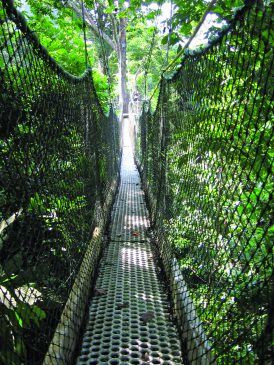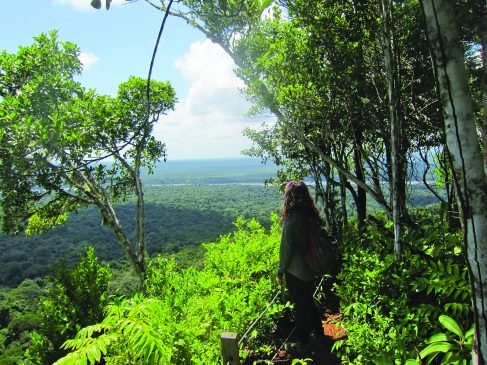
The Iwokrama International Centre for Rain Forest Conservation and Development (Iwokrama) was created in the “run-up” to the Rio Summit in 1992. It is a key environmental programme dedicated by the Government of Guyana, through President Desmond Hoyte, to the Commonwealth in 1989 at the Commonwealth Heads of Government meeting in Malaysia.
Since its foundation, through an Act of Parliament in 1996, signed off on
by then President Cheddi Jagan, Iwokrama has sought to advance best practices in the sustainable management of the world’s remaining rainforests.
Iwokrama manages the 371,000 hectares (nearly one million acres) Iwokrama Forest in central Guyana to show how tropical forests can be conserved and sustainably used for ecological, social and economic benefits to local, national and international communities.
Iwokrama was originally the name of a mountain range in the forest; the word Iwokrama is from the Makushi tribal nation and means “Place of refuge”. The legend is: long ago, there was inter-tribal warfare and the Makushi people fled into the Iwokrama Mountains to seek refuge.
Iwokrama is a unique institution that is firmly grounded in the reality of the people who live in tropical forests and whose entire economies rest on the fate of their environment. It aims to show that forests are “worth more alive than dead” and that you can “use a forest without losing it” .
The million-acre reserve is zoned into two areas – the Sustainable Utilisation Area (SUA), which allows managed activities and the Wilderness Preserve (WP), which only allows low-impact research and is kept as a control area to keep a check on activities in the SUA.
Iwokrama’s work is very multifaceted. The initial work involved research to acquire baseline data to set the foundation of further scientific research and also the management of the area. The organisation also had to focus efforts on building up partnerships, including with the Macushi communities in and around the Iwokrama Forest.
Iwokrama operates in close partnership with a wide range of local, national and international partners. The Centre’s two founding partners are the Government of Guyana and the Commonwealth Secretariat.

Iwokrama also has a close working relationship with the 20 local Indigenous communities in close proximity to the Iwokrama Forest. These communities fall under the umbrella organisation – the North Rupununi District Development Board (NRDDB), which was established in 1996.
The Centre has also produced some cutting-edge and complex benefits sharing and shareholder agreements with local communities, including a Collaborative Management Agreement that gives the NRDDB a direct say in how the Iwokrama Forest is managed.
Capacity building includes building the capacity of local, national, regional and international communities and both the Private and Public Sectors on the various facets of Iwokrama’s work – conservation, research, monitoring, and community engagement. Iwokrama played a major role in the production of a climate change manual, the only one of its kind in Guyana which is now widely used nationally and has been translated into over six languages for international use.
Over the years, the Centre has trained over 200 persons in areas of ranger training, guide training, protected areas management and collaborative management to support the Guyana Protected Areas System. Interns, volunteers and researchers come to work and conduct research at Iwokrama, and the Centre has been getting more visits from universities, schools and other environmental groups.
Inherent in Iwokrama’s successful management practices is the recognition of traditional Indigenous knowledge, which is twinned with scientific information for best results.
According to Iwokrama, conservation has to be paid for and as the saying goes “Conservation without money is just a conversation”. Iwokrama has several means of support, including from the Government of Guyana, several projects which are usually secured due to competitive applications, partnerships with the corporate community and other donors, and more.
Iwokrama also has been engaging in business activities with the main aim to develop models of using the forest and sharing lessons learnt in the process. Iwokrama, currently, has two tourist lodge facilities, the only canopy walkway in the hemisphere and several tours on offer.

The sustainable forestry business commenced in 2008 and is currently certified under the guidelines of an international forest organisation. Both these businesses have been developed with the engagement of Private Sector partners.
Owing to the many activities that Iwokrama undertakes, and given the reality of public access via the road that runs through the reserve and also the bordering rivers, Iwokrama has an extensive established monitoring programme. The impacts of public access and impacts of Iwokrama’s activities must be checked and some of the areas monitored include biodiversity, water quality, weather, traffic, waste and social aspects to name a few.
In the global context, Guyana is part of one of four remaining large tracts of intact forest ecosystems in the world known as the Guiana.
Iwokrama Mission
“To promote the conservation and the sustainable and equitable use of tropical rain forests in a manner that will lead to lasting ecological, economic and social benefits to the people of Guyana and to the world in general, by undertaking research, training and the development and dissemination of technologies.”
Iwokrama’s core values
• A people centered approach to conservation and wise use;
• Developing low volume, high value markets for all forest products and services;
• Encouraging local, national and international partnerships for development; and
• Active learning by doing



